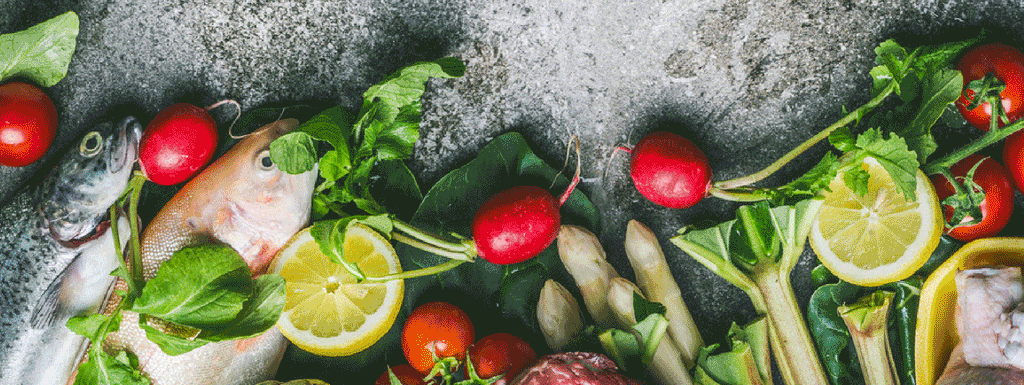The Paleo and keto diets are amongst the most popular diets right now. From bloggers to trainers and athletes alike, there has been an immense buzz over these two diets.
When it comes to burning fat, accelerated weight loss, and healthy living, both diets do measure up, but each has its own purposes and differences. Let’s take a look at the similarities and differences, as well as which is the right choice for you.
What is the Ketogenic Diet?
The primary purpose of the ketogenic diet, or keto, is usually for dramatic weight loss, but the diet can improve certain medical conditions, such as type 2 diabetes and Alzheimer’s disease.
The ketogenic diet is designed to induce ketosis to change the body’s metabolism from one that uses carbohydrates as the primary fuel source to one that uses fats.
Ketosis occurs naturally when the body is in “starvation mode”. In the keto diet the “starvation mode” is manipulated by controlling the amounts of fats, carbs, and proteins that the body receives. We can achieve this by consuming under 20 net grams, roughly 5% diet, of carbohydrates per day. On the other end, fat intake must be at around 65-95% of your daily diet. Protein intake should be at approximately 5-25% of daily intake. You can read more about the keto diet here.
What is the Paleo Diet?

The primary purpose of Paleo is for lifestyle weight maintenance. This diet can also be for gut health, autoimmune health improvement, blood sugar balance, and weight loss. Proponents of Paleo have claimed that it is a nutritional way to stay lean, muscular, and energetic.
The idea of Paleo, or caveman diet, is to cut out foods in our modern diet that are high in sugar and processed foods to return to a diet that is more natural and holistic. In Paleo you should avoid processed foods, grains, legumes, and most kinds of dairy.
The diet consists of healthy proteins, fruits and vegetables, and healthy fats. Because there is not an exact number of macronutrients to count, this means that is the diet is less restrictive than the ketogenic diet regarding the types of foods you can consume. You should be eating organic meats, including non-standard cuts like organ meats. All fruits and vegetables are acceptable, and fats from healthy sources such as nuts, seeds, avocados, fish oil, and grass-fed animals.
The health benefits from this type of diet are improved blood lipids, weight loss, and reduced pain from autoimmunity. The idea is that the Paleo diet removes foods from our diet that is hard to digest or trigger the insulin response and replaces these foods with natural foods that our ancestors once consumed.
Key differences between the Keto Diet and the Paleo Diet
1. Paleo can be but is not necessarily low-carb, high-fat
Paleo restricts grains, legumes, and refined sugar, but the diet does not limit the number of carbs eaten through fruits starchy vegetables, and natural sweeteners, such as honey or pure maple syrup. On the other hand, the keto diet revolves primarily on restricting the number of carbs consumed, while increasing the number of fats consumed.
2. The keto diet does not restrict dairy
Full-fat dairy products are usually allowed on the keto diet, but Paleo removes foods that are hard for the body to break down.
3. The keto diet requires tracking macronutrients, while Paleo does not
Those following the diet will need to count fats, carbs, and protein meticulously. For those following the Paleo eating regiment, no macronutrient counting is required.
4. Keto aims to burn fat instead of carbs while Paleo does not
The keto diet aims to manipulate the body to induce ketogenesis. In Paleo, it may be possible to achieve ketogenesis, but achieving ketogenesis is not the intended goal.
Determining Which Diet is For You
 Which diet is right for you to will depend on your lifestyle and goals. Individuals with busier lifestyles or less access to a variety of food may find keto challenging to do. Further, keto requires the counting of macronutrients, and if counting macros set you off or is not possible, then the keto diet may not be for you.
Which diet is right for you to will depend on your lifestyle and goals. Individuals with busier lifestyles or less access to a variety of food may find keto challenging to do. Further, keto requires the counting of macronutrients, and if counting macros set you off or is not possible, then the keto diet may not be for you.
On the other hand, Paleo is less restrictive, but you will see much more dramatic outcomes with the keto diet. If you would like to lose weight and live a healthier lifestyle gradually, then Paleo may be for you.
Lastly, you can try both diets at the same time. You can do this by eliminating all dairy, tracking macros, choosing grass-fed or pasture-raised animals, and choosing zero calorie all natural sweeteners such as stevia.
You Can’t Really Go Wrong
Whether you pick a keto or Paleo or both, choosing a diet that is full of whole foods, low carbs, healthy fats, and healthy proteins is a great way to improve overall health. Remember to read labels and stay informed about products that claim they are keto or Paleo – quite a few commercial products don’t actually fit either diet. Because Paleo is mostly about whole foods it can be easy to jump right in; however, when starting a ketogenic diet it can be helpful to start with a meal plan. Junk foods full of sugar, either natural or added, and processed ingredients are not good choices even if the label says they are Paleo or keto.

Leave a Reply